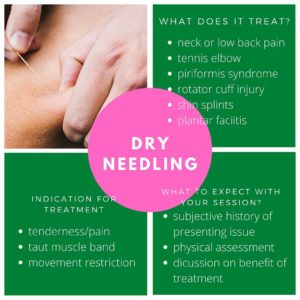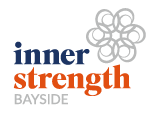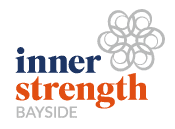Dry Needling Explained
Have you been wondering what exactly dry needling is? We created this article to help answer some of your questions…
What is dry needling?
Dry needling is a procedure where fine needles (finer than what is used for a blood test) are inserted directly into the skin and the muscle for therapeutic purposes. These may include relieving acute and chronic pain, improving muscle length, altering muscle activation patterns or assisting with sleep and relaxation. The therapist may choose a dry needling technique over other manual therapy options as it is often less painful to the person while still being effective in achieving the treatment objective. The needle can be inserted at varying depths depending on the location and the body type of the person being treated.
therapeutic purposes. These may include relieving acute and chronic pain, improving muscle length, altering muscle activation patterns or assisting with sleep and relaxation. The therapist may choose a dry needling technique over other manual therapy options as it is often less painful to the person while still being effective in achieving the treatment objective. The needle can be inserted at varying depths depending on the location and the body type of the person being treated.
What is the difference between dry needling and acupuncture?
Something that confuses many people is the difference between acupuncture and dry needling. Dry needling is a western medicine approach which uses physiological principles and trigger points to reduce pain and increase movement. This technique is only appropriate for musculoskeletal problems and does not play a role in medical illnesses. Traditional acupuncture uses the body’s meridians and other points and is based on an East Asian Medicine approach. This technique can be used for all different manner of illness and injuries. Western acupuncture uses meridian points but applies this to western clinical reasoning.
Why choose dry needling?
Dry needling is not for everyone. For those of you with needle phobias and the thought of needles just makes you feel unwell there are plenty of other options. So, if dry needling is suggested as a good treatment option by your clinician and you would prefer not to, then there will be other options.
Some of the benefits of dry needling are:
- Can be less painful and faster than deep tissue release/ massage with similar effects
- Helps release trigger points (tight bands within muscles) which in turn improves flexibility
- Relieves pain and muscle tightness
- Improve range of motion
- Speeds up healing process – encourages blood flow to the area
What should I expect in a dry needling session?
 Your physiotherapist will ask you a comprehensive history of the presenting problem followed by a physical examination. This assessment will enable the physio to determine what treatment is likely to provide the best outcome. If dry needling is considered, your therapist will explain the goal of dry needling followed by potential post dry needling symptoms you may experience. You will be asked to sign a consent form to demonstrate your understanding of the treatment being delivered.
Your physiotherapist will ask you a comprehensive history of the presenting problem followed by a physical examination. This assessment will enable the physio to determine what treatment is likely to provide the best outcome. If dry needling is considered, your therapist will explain the goal of dry needling followed by potential post dry needling symptoms you may experience. You will be asked to sign a consent form to demonstrate your understanding of the treatment being delivered.
The area undergoing treatment will need to be exposed (ie. not covered by clothes) to facilitate accurate palpation and needle insertion. You may feel slight soreness or discomfort with needle insertion and in some instances, dry needling may cause a slight twitch in the muscle. The length of time the needle is left in the muscle will depend on the therapist and the condition being treated. Dry needling may be an adjunct treatment to other manual therapy and exercise rehabilitation.
Feel free to ask us at your next appointment if dry needling may be appropriate in your treatment.
Written by Caitlin Collenette, Physiotherapist.


